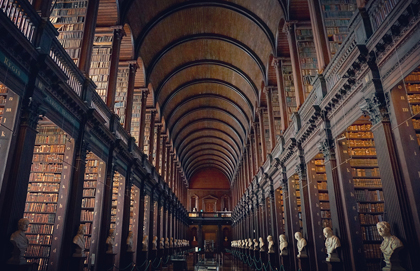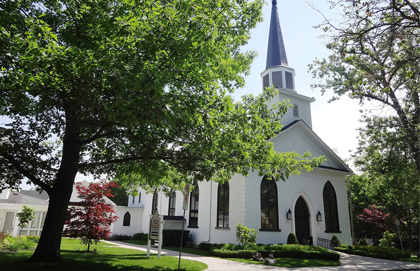Historian and professor George Rawlyk was a bear of a man who was tapped to become a professional football player, but opted for a scholarly life of research, writing and teaching, mostly about evangelical religion’s role in Canadian history. In addition to writing or editing over 30 books and serving as mentor and friend to many graduate students, Rawlyk managed to parlay a research grant from an American foundation into a comprehensive and influential survey on the role of faith in Canada.
Rawlyk was born in the small northern Ontario town of Thorold in 1935. Rawlyk became a Baptist in his teens. His religious life was significantly impacted by Mary Renton, a Christian education worker who was assigned by the Home Mission Board of the Baptist Convention of Ontario and Quebec to a mission in Thorold, where she ministered to the children of Ukrainian immigrants. According to his sister, Olga, Rawlyk attended the mission from the age of four until a teen, and he and Olga actually ran the mission for a few months after Renton’s death in 1957.
Renton’s impact on the boy who lived in an area of a small Ontario town mainly settled by Ukrainian immigrants was deep. Rawlyk described Renton in 1988 as “an unheralded Baptist home missionary who profoundly affected my life and that of many of my contemporaries who lived on the other side of the tracks in Thorold, Ontario.” He dedicated his book, “Wrapped Up In God: A Study of Several Canadian Revivals and Revivalists,” to her.
Rawlyk was always large of stature and exceptionally athletic, and, as a young man, excelled in football and basketball. At Hamilton’s McMaster University, where he began his higher education and met his wife, artist Mary Rawlyk, he played centre on the football team and was named best linesman in 1954 and 1955. In 1957, he was drafted fourth overall by the Canadian Football League’s B.C. Lions team. But he turned the offer down, in favour of accepting a Rhodes Scholarship to attend Oxford University.
According to an article by John G. Stackhouse, after Oxford, Rawlyk received an MA and a PhD at the University of Rochester. He began his teaching career at Mt. Allison University in Sackville, New Brunswick (1959-1961) and then moved to Dalhousie University in Halifax, Nova Scotia, as assistant professor of history (1963-66). In 1966, he began his long association with Queen’s University, serving there as history professor, mentor and advisor until his death in 1995.
His academic output was prodigious. In addition to writing or editing books about religion in Canada and Maritimes history, he co-authored a children’s book. He mentored, advised and oversaw countless graduate students, theses, and scholarly research papers. His reputation preceded him as a large, booming-voiced, tough and demanding professor, but students who lived up to his expectations unexpectedly found in him a loyal friend and supporter.
“Rawlyk was a significant figure, intellectually and physically, with a somewhat intimidating presence. Yet his commitment to his students, his generosity and patience, and his unswerving support, revealed a side of the man sometimes overlooked,” wrote one-time student and Canadian historian W.G. Godfrey.
“With George Rawlyk, one had a ‘relationship,’ with all the emotional enthusiasm the term connotes. Though physically enormous, almost brutal-seeming on first encounter, the Rawlyk one came to know was profoundly empathetic, and he conveyed this empathy with great delicacy,” remembered author and historian D.G. Bell, another of Rawlyk’s students.
Rawlyk had some concern that his work, focusing on a very specific interpretation of Canadian history, that is, 18th century Nova Scotia and the study of the evangelical religion, especially in its Maritime context; would be dismissed by the more scholarly and worldly influences in academic world. Perhaps this is what drove him to complete books focusing on these topics, both of which he strongly felt influenced the Canadian course of history, but were often dismissed as insignificant.
Another area that interested him was the comparison of American and Canadian evangelicals; especially the strong influence of American evangelicals in American politics, whereas Canadian evangelicals appeared to shy away from overtly partisan political involvement.
As a matter of fact, the Pew Charitable Trust of Philadelphia awarded him a grant for a three-year study of Canadian evangelicalism, part of which Rawlyk used in a unique manner. He approached the respected polling firm Angus Reid to “count the number of evangelicals in Canada,” according to the April 1993 edition of Maclean’s magazine, entitled “God Is Alive.”
The first results appeared in January 1993.
‘Angus Reid saw them and the top of his head blew off because he realized the results were very, very important,’ Rawlyk was quoted in the article.
Reid then decided to focus on religion as the topic of his company’s public poll for 1993, expanding the original poll he did for Rawlyk with new questions.
The results were significant.
“What it suggests is that we have to question our assumptions about what Christianity is in Canada,” said Andrew Grenville, Angus Reid’s vice-president.
Among the poll findings: Some 70 per cent of Canadians leaned toward the Christian faith, with about 15 per cent identifying with its evangelical stream. The research categorized Canadian Christians into four classifications, census, ceremonial, customizing and committed. Close to 50 per cent were described as “customizing” – listening to their spiritual leaders with respect, enjoying the fellowship of their attendant congregations or parishes and attending at least every month or two at worship. Committed Christians made up 20 per cent of the total, with the remaining 30 per cent divided between census (how they described themselves to the census-taker) and ceremonial (attending on high holidays or rites of passage ceremonies).
In May, 1995, born of a desire to spread the word on the research on other historical data, Rawlyk pulled together a conclave at Queen’s of over 100 historians who had been involved in various kinds of religious historical research and writing. It turned out to be his swan song. In November, his booming voice was silenced when he died of the results of a car accident.
Faith journalist and sometime amateur historian Lloyd Mackey attended that 1995 conference, which focused on the history of Canadian evangelical experience in the 19th and 20th centuries. Mackey recalls a particularly poignant post-dinner, friendly exchange between Rawlyk and three of his former students, each of which he showed pride in, while recognizing they had followed paths which shaped Canadian faith and politics somewhat differently from his own. (Rawlyk leaned left, like fellow Baptist cleric and New Democratic Party founder Tommy Douglas, for whom he wrote press releases when he, himself, was working his way through university.)
The three were:
- The aforementioned John Stackhouse who, after holding a major professorial chair at Regent College Vancouver, moved in recent years to a similarly prestigious posting at Crandall University in Moncton, New Brunswick.
- Darrel Reid, who served variously as deputy chief of staff for former prime minister Stephen Harper and president of Focus on the Family Canada.
- Paul Wilson, who was research director for Harper, then founding director of Trinity Western University’s Laurentian Leadership Centre in Ottawa, before moving on his present teaching role at Carleton University’s School of Political Management.
While the conference itself is history, Rawlyk saw to it that its proceedings and papers were preserved for posterity. Two years after he died, McGill-Queens University Press published Aspects of the Canadian Evangelical Experience, which he had edited before his death.
Among its contributors: Phyllis D. Airhart, Alvyn J. Austin, David W. Bebbington, Edith L. Blumhofer, Robert K. Burkinshaw, Sharon Anne Cook, Nancy Christie, P. Lorraine Coops, Duff Crerar, Michael Gauvreau, Daniel C. Goodwin, Andrew S. Grenville, Bruce L. Guenther, Bryan V. Hillis, D. Bruce Hindmarsh, Mark Hutchinson, William H. Katerberg, Kevin Kee, Ronald A.N. Kydd, Barry Mack, Mark A. Noll, David Plaxton, Darrel R. Reid, John G. Stackhouse, Jr, Marguerite Van Die, Richard W. Vaudry, and Marilyn Färdig Whiteley.
Rawlyk died in hospital in Ottawa on November 23, 1995, two weeks after his accident. He was survived by his wife, artist Mary Rawlyk, and two daughters, Anna and Miriam.
Laurie McBurney is a veteran journalist and feature writer whose work has appeared in various Canadian mainstream and faith-based publications. She lives in Kingston, Ontario, where George Rawlyk did much of his life’s work.






